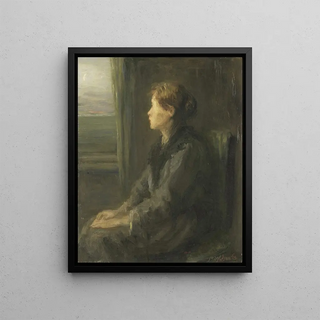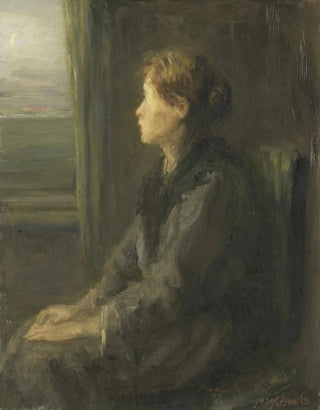Art print | Woman at the window - Jozef Israëls


View from behind

Frame (optional)
In the fascinating world of art, some works manage to capture the very essence of humanity. "Femme à la fenêtre" by Jozef Israëls is a perfect example. This canvas, imbued with melancholy and contemplation, invites us to delve into the inner world of a woman whose gaze seems lost in the horizon. The scene, both intimate and universal, evokes deep emotions and resonates with anyone who has ever experienced loneliness or the search for meaning. Through this art print, the viewer is not only a witness to a frozen moment in time but also to a reflection on the human condition.
Style and uniqueness of the work
Jozef Israëls' style is characterized by an exceptional mastery of light and shadow, creating an atmosphere filled with realism and poetry. In "Femme à la fenêtre," each brushstroke appears to be charged with a specific intention, where delicate nuances of the palette highlight the protagonist's emotions. The composition, focused on the female figure, draws the eye and fosters an immediate connection. The window, a symbol of openness and escape, becomes a key element of the work, suggesting both confinement and hope for an outside world. The depiction of the woman, at once vulnerable and strong, reflects the artist's particular sensitivity to the feminine, making this work disturbingly modern.
The artist and his influence
Jozef Israëls, an emblematic figure of the Dutch realist movement of the 19th century, knew how to leave his mark on his era through a unique approach to painting. Raised in an artistic environment, he was heavily influenced by the great masters of Dutch painting, while developing a personal vision that was his own. His commitment to representing everyday life, often imbued with nostalgia, allowed him to reach a broad audience. "Femme à la fenêtre" fits within this lineage, where the artist seeks to immortalize moments of life while questioning the place of the individual in society. Israëls was also a pioneer in the representation of human emotions.

Matte finish

View from behind

Frame (optional)
In the fascinating world of art, some works manage to capture the very essence of humanity. "Femme à la fenêtre" by Jozef Israëls is a perfect example. This canvas, imbued with melancholy and contemplation, invites us to delve into the inner world of a woman whose gaze seems lost in the horizon. The scene, both intimate and universal, evokes deep emotions and resonates with anyone who has ever experienced loneliness or the search for meaning. Through this art print, the viewer is not only a witness to a frozen moment in time but also to a reflection on the human condition.
Style and uniqueness of the work
Jozef Israëls' style is characterized by an exceptional mastery of light and shadow, creating an atmosphere filled with realism and poetry. In "Femme à la fenêtre," each brushstroke appears to be charged with a specific intention, where delicate nuances of the palette highlight the protagonist's emotions. The composition, focused on the female figure, draws the eye and fosters an immediate connection. The window, a symbol of openness and escape, becomes a key element of the work, suggesting both confinement and hope for an outside world. The depiction of the woman, at once vulnerable and strong, reflects the artist's particular sensitivity to the feminine, making this work disturbingly modern.
The artist and his influence
Jozef Israëls, an emblematic figure of the Dutch realist movement of the 19th century, knew how to leave his mark on his era through a unique approach to painting. Raised in an artistic environment, he was heavily influenced by the great masters of Dutch painting, while developing a personal vision that was his own. His commitment to representing everyday life, often imbued with nostalgia, allowed him to reach a broad audience. "Femme à la fenêtre" fits within this lineage, where the artist seeks to immortalize moments of life while questioning the place of the individual in society. Israëls was also a pioneer in the representation of human emotions.






